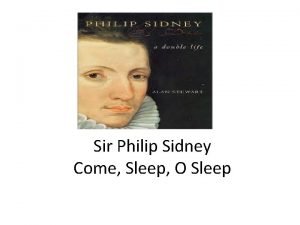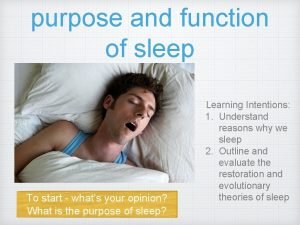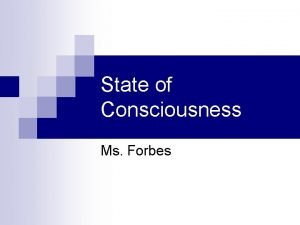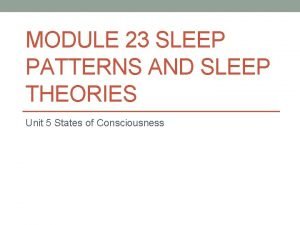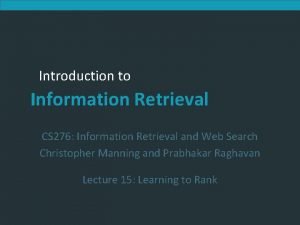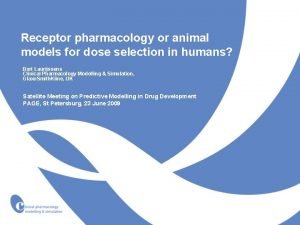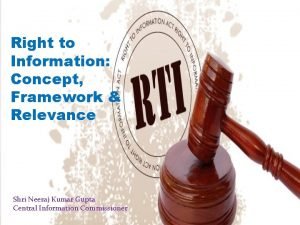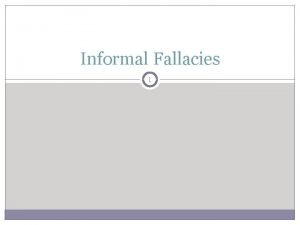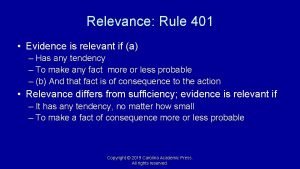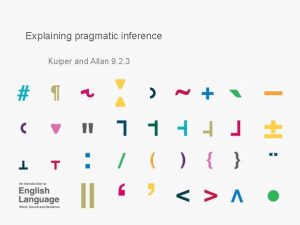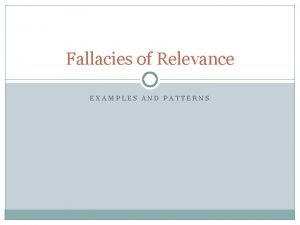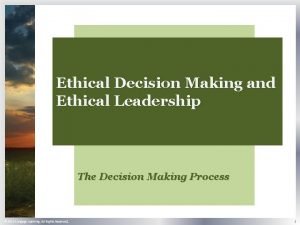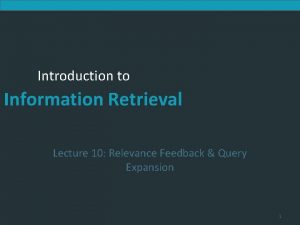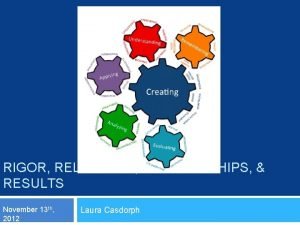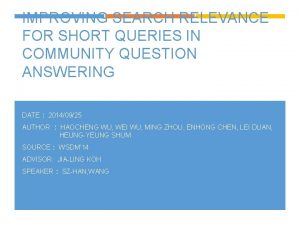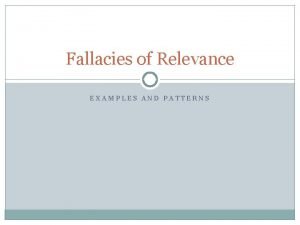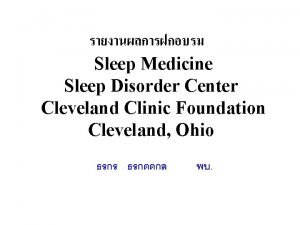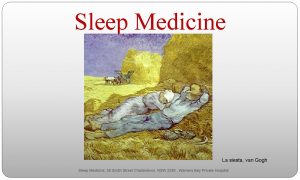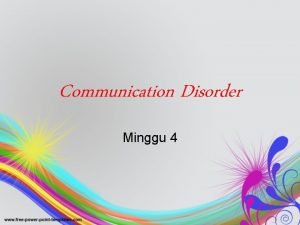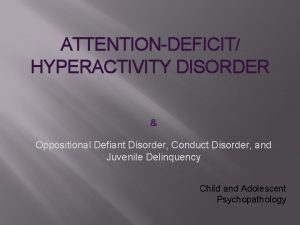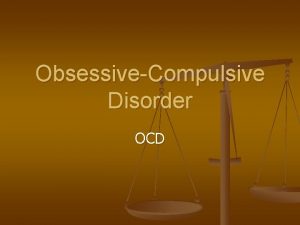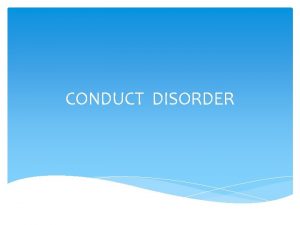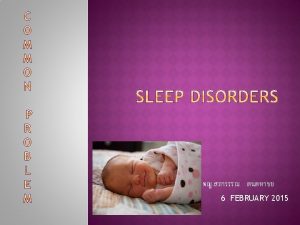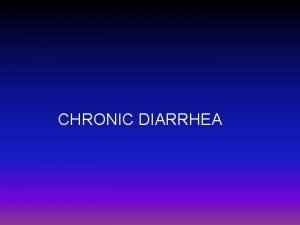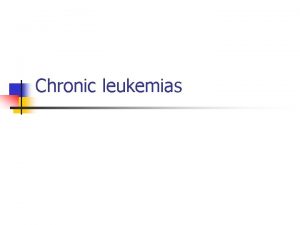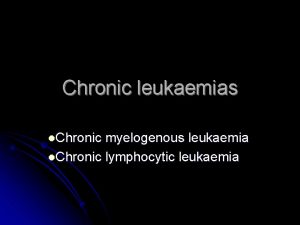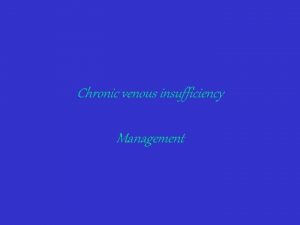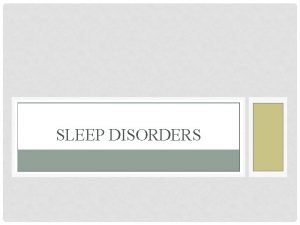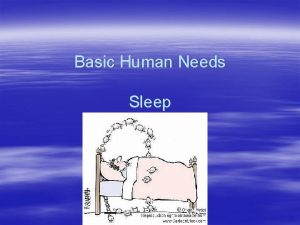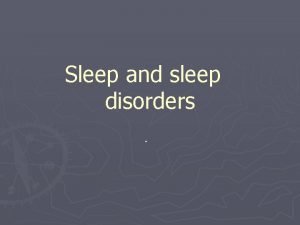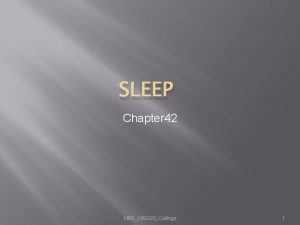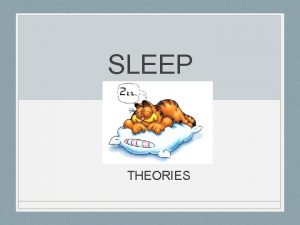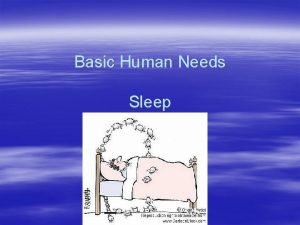Sleep Medicine Relevance of Sleep Disorder for Chronic
















































- Slides: 48

Sleep Medicine: Relevance of Sleep Disorder for Chronic Pain Specialist JOE FO RRESTER, MD: NO FINANCIAL CONFLIC TS BOARD CERTI FIED SLEEP MEDICINE SLEE P DI RECTOR: THE MEDICAL CENTER O F AU R OR A NORTH SUBURBAN ME DICAL CENTER

Overview • Prevalence of Sleep Disorders in General Population • Increased Prevalence in Chronic Pain Patients • Relationship between Sleep and Chronic Pain • How to Evaluate Sleep Disorders • Role of Polysomnogram • Central Sleep Apnea’s Relationship to Chronic Narcotic Use

Prevalence of Sleep Disorder Symptoms in the General Population • Insomnia- perception of inadequate sleep or ability to feel rested. • 30% of population intermittent • 6 -15% chronic insomnia. • Hypersomnia- excessive daytime sleepiness • 9% of general population • Sleep Apnea found in 2 -4% • RLS 5% • Narcolepsy 0. 04% • Depression and Chronic Pain- Bidirectional JAMA. 1989; 262(11): 1479 -1484. Sleep Medicine Research (SMR) 2011; 2(1): 1 -9.

Symptoms of a Sleep Deprivation are more Common in patients with Chronic Pain than in General Population • Chronic Insomnia • 40%-70% of chronic pain patients complain of poor quality sleep based on Pittsburgh Sleep Quality Index score. • 20% of patients with chronic neck and back pain report sleeping less Eur Rev Med Pharmacol Sci. 2014; 18(17): 2475 -81. than 4 hours per night. • Hypersomnia? • 36% of 140 patients in a pain clinic who were not screed for risk of sleep apnea underwent polysomnograms and were found to have severe sleep apnea with an AHI >30/hr. Pain Med. 2008 May-Jun; 9(4): 425 -32

Pain and Fragmented Sleep Share other Comorbidities • Sleep and pain disorders share increased frequency: obesity, type 2 diabetes mellitus, and depression. • Many Patients with Chronic Pain have other medical conditions that have a high incidence of sleep disorders. • • • COPD Cerebral Vascular Disease Atrial fibrillation Hypertension CHF

What is the Impact of Pain on Sleep • Reduced sleep duration and efficiency. • Less control over sleep. • Worry about lack of sleep effecting their health • More sensitive to environmental factors: noise, light, temperature, etcetera. • 2015 Sleep in America Poll • Chronic pain patients sleep on overage 42 minutes less • Only 40% of chronic pain patients report good or very good quality sleep.

Interim Summary • Sleep disorders are common in chronic pain patients • Both insomnia and hypersomnia are common symptoms • Comorbidities Increase the prevalence of sleep disorders in chronic pain patients.

Directional Model of Sleep and Pain Insomnia Sleep Deprivation Or Fragmentation Pain Hypersomnia Finan, Patrick et al. The association of sleep and pain: Anupdate and a path forward. J Pain 2013

Data Supporting the Directional Relationship: Insomnia Pain • Danish patients with insomnia and infrequent episodic tensionheadaches were more likely to develop chronic tension type headaches. Eur J Epidemiol. 2005; 20: 243 -249. • Insomnia symptoms in a headache-free Norwegian population was predictive of both the development of tension-type and migraine headaches over an 11 years follow-up. The Journal of Head and Face Pain. 2011; 51: 570 -580. • Population based study found that insomnia symptoms at baseline significantly increased the risk of developing chronic musculoskeletal pain at 17 years follow-up. Scandinavian Journal Pain. 2012; 3: 210 -07. • Population based study of Norwegian women found that women who reported frequent difficulty falling asleep or having sleep disorder were significantly more likely to develop fibromyalgia. Arthritis Rheum. 2012; 64: 281 -4. • Transition from insomnia to Quality sleep over 15 months has been shown to predict resolution of chronic widespread pain syndrome. Rheumatology 2008: 47, 1809 -1813

Data Supporting the Directional Relationship: Pain Insomnia • Tang compared 70 patients with chronic back pain to 70 age -gender matched pain-free controls. • Measured sleep disturbance, pain perception, health status, anxiety and depression, and other psychologic variables. Clinical Insomnia was Reported in: 53% of chronic pain patients 3% of controls • Insomnia severity associated with pain severity and general anxiety • Mc. Craken et al evaluated 159 patients referred to a pain center for sleep disturbance. • 79% met criteria for significant insomnia based on self reporting

Data Supporting the Directional Relationship: Hypersomnia Pain • 22 Healthy subjects subjected to 2 nights of sleep deprivation(<4 hours) increased frequency of pain complaints and this effect increased as the number of nights of partial sleep deprivation increases. Pain. 2005; 119: 56 -64. • A study of 27 normal controls and 27 patients with RA underwent 4 hour sleep restriction for one night. • pain, fatigue, depression and anxiety was reported by the RA patients but not controls. Disease specific measures of pain severity and painful joint counts increased in the RA patients. Sleep 2012; 35; 537. • A Forced Awakening study in a small group of otherwise normal female subjects resulted in increase report of spontaneous pain. • Women with OSA have a 10 fold increased frequency of Fibromyalgia.

Objective Testing of Sleep in patients with Insomnia finds less severe disruption than when Subjective reporting by Patients with Chronic Pain • Self reported sleep diaries overstate SOL, loss TST, WASO, reduced SE when compared to Actigraphy or PSG. • Insomnia patients with or without pain have a similar difficulty with sleep maintenance on nocturnal PSG testing. • Minor Changes in SOL, TST, WASO, SE on nocturnal PSG • No Consistent change in sleep architecture • No increase in PLMS • No Increase in Sleep Apnea without comorbidities or respiratory affecting medications

Summary • Strong support for bidirectional relationship between fragmented sleep and pain. • Patient self report sleep disturbance more frequently than objective measurements. • Insomnia reported more frequently than hypersomnia. • Few changes in nocturnal polysomnograms in patients with chronic pain and insomnia compared to controls

Evaluation Tools for Patients with Disruptive Sleep Symptoms • Efficient evaluation for sleep disorder for patients in your practice • Questionnaire • Personal Sleep Tracker, Actigraphy, or Sleep Log • Sleep Study: Home or In-lab sleep study

Questionnaires as Screening Tools Over 30 to choose from • Time efficient • Easy for office staff to use • Reasonable sensitivity and Specificity

Insomnia Severity Index rate in the last 2 weeks 7 symptoms < 8 no significant insomnia; >15 insomnia or sleep problem Item ISI Item response choice* 0 1 2 3 4 1. falling asleep 2. staying asleep 3. Early awakening 4. satisfaction 5. interference 6. noticeable 7. worry 0 no problem and 4: (very severe, dissatisfied, interfere, noticeable, worried, )

Hypersomnia Sleep Questionnaire • Berlin Questionnaire • 11 questions • Epworth Sleepiness Scale • 24 point scale • STOP-BANG Questionnaire • 8 Questions

STOP-BANG Questionnaire Simple: no 0/yes 1 • Stop • Tired • Observed • Pressure • BMI AGE • AGE (>50) Neck Size • Neck Size (17 in) Gender • Gender (M) Low risk: 0 -2 Intermediate 3 -4 High 5 -8

Tools for Tracking Sleep over Time • Personal Sleep Tracker: A number of smart phone/watch products such as: Use with Sleep Diary. • Sleep tracker • Autosleep • Two week Sleep Diary- Subjective • Actigraphy an office based device with CPT code- Objectivity • Day/night • Sleep and wakefulness based on movement

Polysomnograms • Unexplained Insomnia—particularly in women • Hypersomnia • Nocturnal Hypoxemia • Presence of comorbidities with risk OSA • Obesity, atrial fibrillation, CHF, COPD, CVA • Presence of comorbidities with high risk of CSA. • Narcotic Use

Insomnia History suggests to you Insomnia Severity Index: > 15

Causes of Chronic Insomnia: • Psychiatric disorders • Medical disorders: COPD, CHF, GERD, Endocrine disorders • Medications • Neurologic disorders • Sleep disorders: OSA/CSA; RLS; Circadian Rhythm disorders

Evaluation and Treatment of Chronic Insomnia for Pain Specialist • Non-pharmacotherapy • Components of CBT-I that can be provided by pain specialist • Assess the risk for Hypersomnia Syndromes • Ordering a Sleep Study • Medications for Insomnia • Non-dependent • Dependent • Psychiatric or Insomnia Specialist

Components of CBT-I than can be partially addressed more simply and with Handouts • Sleep hygiene • Increases patients awareness of behavior or environmental factors that impact sleep • Stimulus control • Limit use of bed to sleep and sex, limit daytime naps • Sleep restriction • Limit time in bed to actual sleep time

Medications for Insomnia NON-ADDICTIVE • Melatonin/ramelteon-hallucinations • Orexin antagonists – very limited benefit and expensive • Antidepressant-neuropathic pain/CGP • Antipsychotics Anxiolytic—anxiety • Gabapentin—neuropathic pain and RLS • Non-benzodiazepine GABA receptor • reports possible contribution to death when used in combination with opiates • Zolpidem/zaleplon • Eszopiclone- antidepressants/ anxiolytics ADD ICTIVE • Benzodiazepine • Potentiates Respiratory Depression • Opiates- RLS

Cognitive Behavior Therapy for Insomnia • Has been shown to improved sleep in patients with Chronic Pain and sustain improvement for 6 months • Equally effective or more effective than pharmacotherapy • Referral to a Professional trained in CBTI • • • Psychoeducation about sleep and Insomnia Stimulus control Sleep restriction Sleep hygiene Relaxation training Cognitive Therapy

Hypersomnia History or observation suggests sleepiness Supporting Questionnaire –STOP-BANG: >8

Diagnosis Tests and Causes for Hypersomnolence • Sleep Apnea— PSG • RLS- Historical Diagnosis • Narcolepsy-PSG/MSLT • Insufficient Sleep-History • Depression- History/Questionnaire • Circadian Rhythm Disorders- Sleep Diary

Treatment of Hypersomnia Conditions • OSA---CPAP/Dental Devices/Surgery • RLS-----Iron replacement, symptomatic treatment, Dopamine agonists, gabapentin, opiates • Narcolepsy----wakefulness medications • Insufficient Sleep------Sleep Hygiene Education • Depression-----Antidepressants • Circadian Rhythm Disorders—Light therapy/melatonin

Narcotics and Central Sleep Apnea

Narcotics for Pain and SDB *In 1997 the American Academy of Pain Medicine and the American Pain Society stated that “it is now accepted…that respiratory depression induced by opioids tends to be a short lived phenomenon, generally occurs only in opioid-naïive patients and is antagonized by pain. Therefore, withholding the appropriate use of opioids from a patient who is experiencing pain on the basis of respiratory concerns is unwarranted. ” * In 2007 the broad spectrum of SRBD under opioids were described retrospectively by Walker et al. Besides obstructive disturbances, they found central apneas, ataxic or irregular respiration, and periods of sustained hypoventilation. Winifred, et al. Opioid Induced Sleep Apnea: Is it a real problem. J Clin Sleep Med 2012

Prevalence of Sleep Apnea in Patients on Chronic narcotics for Pain control • Recent studies have shown that 75 -85% of patients on opioids have at least mild sleep apnea, and 36 -41% have severe sleep apnea, of which the severity is dose dependent. • Mogri etal. Hypoxemia in patients on chronic opiate therapy with and without sleep apnea. Sleep Breath. 2009; 13: 49 – 57 • 36% of 140 patients in a pain clinic who underwent polysomnograms independent of risk factors for sleep apnea had an AHI >30/hr. — severe. • Pain Med. 2008 May-Jun; 9(4): 425 -32 • 20 patients referred to a sleep center from a pain clinic with symptoms c/w sleep apnea had an average AHI was 64/hr. • 16/20 had central sleep apnea. • J Clin Sleep Med. 2014 Jun 15; 10(6): 637– 643.

• Medical Malpractice and prescription painkillers • The following are examples of medical malpractice when doctors negligently prescribe prescription painkillers that may injure, harm, or even cause death to patients. • Some physicians place patients on high doses of painkillers when unnecessary, putting them at risk of an overdose • Patients are treated with these drugs for longer than necessary, increasing the likelihood that they may become addicted • Patients are not a proper candidate for a particular opioid painkiller, but it's prescribed to them anyway (e. g. patients suffer from conditions such as sleep apnea and pulmonary problems) which make the use of opioid painkillers very dangerous. • Patients are switched from one powerful painkiller to another by their doctor (practice is known as opioid rotation) may also face serious health risks, either from an interaction between two drugs, or because a new medication is much stronger than the old.

Opiate Effect on Breathing • Suppress respiratory rate and tidal volume by directly binding to mu receptors in CNS. • Most patients have little or no daytime hypercapnia unless the narcotic dose is very high or the patient has comorbidities such as CHF or COPD. • Narcotics may also disrupt sleep architecture by decreasing stage REM sleep, stage N 3 sleep, and reduce sleep efficiency. • Large number of arousals from sleep due to inducing sleep related breathing disorder. • J Clin Sleep Med. 2014 Jun 15; 10(6): 637– 643.

What does Central Sleep Apnea look like in Chronic Narcotic Use • Occurs during non-REM Sleep • Somewhat chaotic pattern of breathing between apnea episodes---Very different from Cheyne Stokes apneas. • Apnea events have variable duration • Often high frequency

Patterns of Central Sleep Apnea Biot’s Breathing * Pattern in Narcotic associated Images from SEEK ACCP for sleep medicine 2017 Cheyne Stokes Breathing * pattern in CHF with low EF

Typical PSG in a patient with Narcotic Induced CSA

How do you evaluate Sleep Apnea in a Patient with Chronic Pain? • Index of suspicion that it is present • Establish risk of isolated OSA vs. mixed OSA/CSA • Comorbidities? • Decide test: • Home Sleep Testing or In-lab Polysomnogram

Home Sleep Testing Unattended • Level III HST devices require 4 channels • 2 devices: airflow and respiratory movement • ECG or pulse • Oxygen saturation • Watch. PAT • Peripheral arterial tone---also pulse and oxygen saturation • Respiratory Effort generator • Does Not measure of flow • Do not measure limb movements • Most Record time in bed not sleep time or sleep stages although many combine with actigraphy to determine sleep time

Watch. Pat Home Sleep Testing device • PAT signal • Peripheral Arterial Tone • Central Pulse Respiratory Effort generator

When do you use Home Sleep testing and when do you order in-lab testing? • Home sleep Testing(Type III) • Patients with high pretest probability of OSA who are candidates for Auto-PAP. • Patients unlikely to need supplemental oxygen • Low pretest probability of OSA • CSA? —screening tool • Low pretest probability • Does not want an in-lab test • Assist with guiding narcotic therapy • In-lab Sleep testing • Patients with insomnia • Patients with specific comorbidities • COPD with hypoxemia • CVA • CHF • Patients with significant risk of central sleep apnea • CHF with LV failure • Narcotic associated CSA

Benefit of In-Lab Sleep Study • Evaluates total sleep time rather than time in bed • Measure airflow rather than a surrogate for airflow such as vascular tone. • Attendant can ensure device is applied and adjusted correctly. • Measures Sleep, Respiration, and body movement disorders. • Therapy for central sleep apnea the same night. • ASV • Approval for supplemental oxygen the same night.

ASV is the PAP treatment of choice for narcotic associated CSA • Studies now support adaptive servo ventilation(ASV) with or without demonstration of CPAP failure during in lab diagnostic split night sleep study. • ASV can eliminate Central Apneas. J Clin Sleep Med. 2014 Jun 15; 10(6): 637 -43. J Clin Sleep Med. 2012 Oct 15; 8(5): 569 -76. J Clin Sleep Med. 2008 Aug 15; 4(4): 305 -10.

Ordering In-Lab Split Night Sleep Study in Patients on Chronic Narcotics • Specify Split night study • State in the order risk for CSA due to narcotic use and titrate with ASV if CSA present.

What is ASV? • It is a pressure therapy like CPAP or Bilevel. • Detects pauses in breathing—Apneas • Ensures a certain number of breath per minute in patients who fail to initiate a breath. • Varies the inspiratory pressure support based on that breaths inspiratory pressure needs. • Does not ensure a tidal volume.

When should ASV not be used? • Patients with Cheyne Stokes central apneas and systolic heart failure with ejection fraction less than 45%. • SERVE-HV study NEJM 2015 • Patients who need non-invasive volume regulated ventilation. • Neuromuscular weakness disorders • Chronic severe hypoventilation • Severe COPD with hypercarbia

Summary: Insomnia Sleep Deprivation Or Fragmentation Pain Hypersomnia

Summary • Simple screening for sleep disturbance in patients with chronic pain is important. • Screening can be adequately performed with simple questionnaires for Insomnia and hypersomnia. • Some aspects of Insomnia can be managed relatively simply by non psychiatrists/therapists. • Sleep studies are important for patients with hypersomnia or chronic narcotic therapy. • Generally in-patient sleep studies should be performed in those who have a risk for central sleep apnea. • Narcotic associated central sleep apnea is best treated with ASV modality when patients must continue narcotic analgesics. • Bilevel ASV is not a mode for patients who need an ensured tidal volume.
 Dsm 5 munchausen by proxy
Dsm 5 munchausen by proxy Sleep panic disorder
Sleep panic disorder Module 23 sleep patterns and sleep theories
Module 23 sleep patterns and sleep theories Come sleep o sleep analysis
Come sleep o sleep analysis Module 23 sleep patterns and sleep theories
Module 23 sleep patterns and sleep theories Adults spend about ______% of their sleep in rem sleep.
Adults spend about ______% of their sleep in rem sleep. Module 16 sleep patterns and sleep theories
Module 16 sleep patterns and sleep theories What is fallacy of relevance
What is fallacy of relevance Relevance in education
Relevance in education Esg relevance scores
Esg relevance scores Cs 276
Cs 276 Rigor relevance relationships
Rigor relevance relationships Clinical relevance
Clinical relevance Rigor/relevance framework
Rigor/relevance framework Relevance
Relevance Relevance information retrieval
Relevance information retrieval Importance of entrepreneurship education
Importance of entrepreneurship education Relevance feedback in information retrieval
Relevance feedback in information retrieval Objectivity in technical writing
Objectivity in technical writing The perceived relevance or importance of an ethical issue
The perceived relevance or importance of an ethical issue Relevance information retrieval
Relevance information retrieval Relevance lost the rise and fall of management accounting
Relevance lost the rise and fall of management accounting Rigor relevance and relationships in action
Rigor relevance and relationships in action Fallacy of accident
Fallacy of accident Relevance of note making
Relevance of note making 401 relevance
401 relevance Relevance information retrieval
Relevance information retrieval Pseudo relevance feedback
Pseudo relevance feedback Origin of medicinal plants
Origin of medicinal plants Relevance theory in pragmatics
Relevance theory in pragmatics Christine counsell significance
Christine counsell significance Rigor relevance and relationships in action
Rigor relevance and relationships in action Example of attacking the motive fallacy
Example of attacking the motive fallacy Directive principles of state policy notes
Directive principles of state policy notes Topical relevance
Topical relevance Maxim of relevance
Maxim of relevance Ethical habits
Ethical habits Relevance information retrieval
Relevance information retrieval What is concept description in data mining
What is concept description in data mining Chris cuozzo
Chris cuozzo Rigor relevance and relationships in action
Rigor relevance and relationships in action Rigor relevance relationships
Rigor relevance relationships Improving search relevance
Improving search relevance Example of relevance
Example of relevance Rigor and relevance checklist
Rigor and relevance checklist Bra mat för unga idrottare
Bra mat för unga idrottare Smärtskolan kunskap för livet
Smärtskolan kunskap för livet Teckenspråk minoritetsspråk argument
Teckenspråk minoritetsspråk argument Etik och ledarskap etisk kod för chefer
Etik och ledarskap etisk kod för chefer



